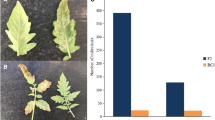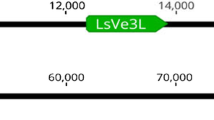Abstract
The Alternaria stem canker disease of tomato is caused by the necrotrophic fungal pathogen Alternaria alternata f. sp. lycopersici (AAL). The fungus produces AAL toxins that kill the plant tissue. Resistance to the fungus segregates as a single locus, called Asc, and has been genetically mapped on chromosome 3 of tomato. We describe here the establishment of a 1383-kb YAC contig covering the Asc locus and a series of plants selected for recombination events around the Asc locus. It was shown that the YAC contig corresponds to a genetic distance of at least 11.2 cM. Thus, the recombination rate in the Asc region is six times higher (123 kb/cM) than the average for the tomato genome. Furthermore, the Asc locus could be localised to a 91-kb fragment, thus paving the way for the cloning and identification of the Asc gene(s) by complementation.
Similar content being viewed by others
Author information
Authors and Affiliations
Additional information
Received: 31 July 1998 / Accepted: 6 October 1998
Rights and permissions
About this article
Cite this article
Mesbah, L., Kneppers, T., Takken, F. et al. Genetic and physical analysis of a YAC contig spanning the fungal disease resistance locus Asc of tomato (Lycopersicon esculentum). Mol Gen Genet 261, 50–57 (1999). https://doi.org/10.1007/s004380050940
Issue Date:
DOI: https://doi.org/10.1007/s004380050940




